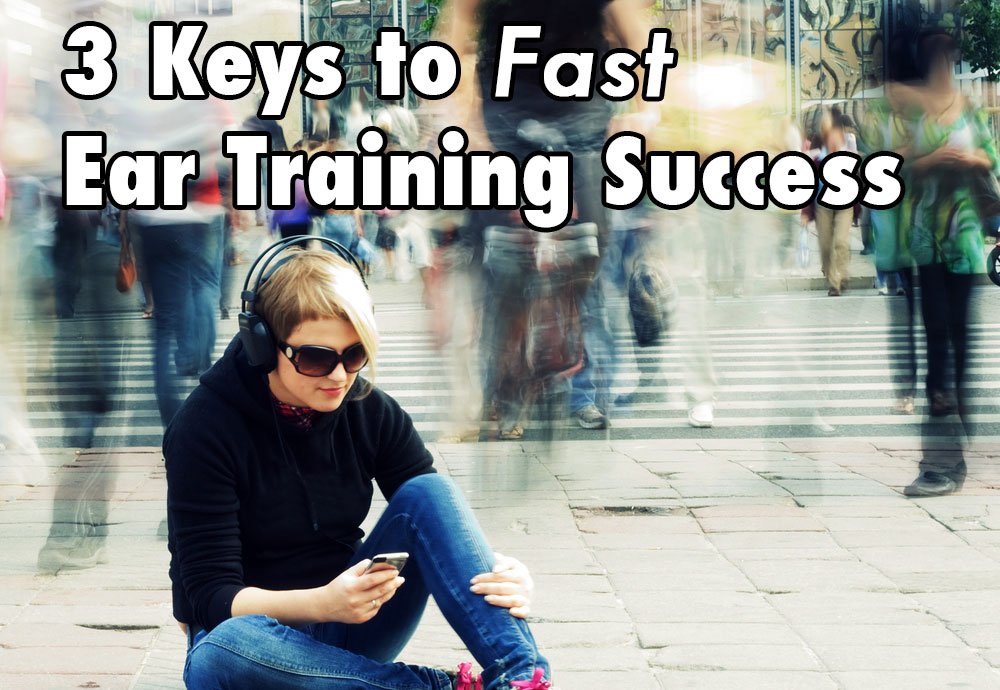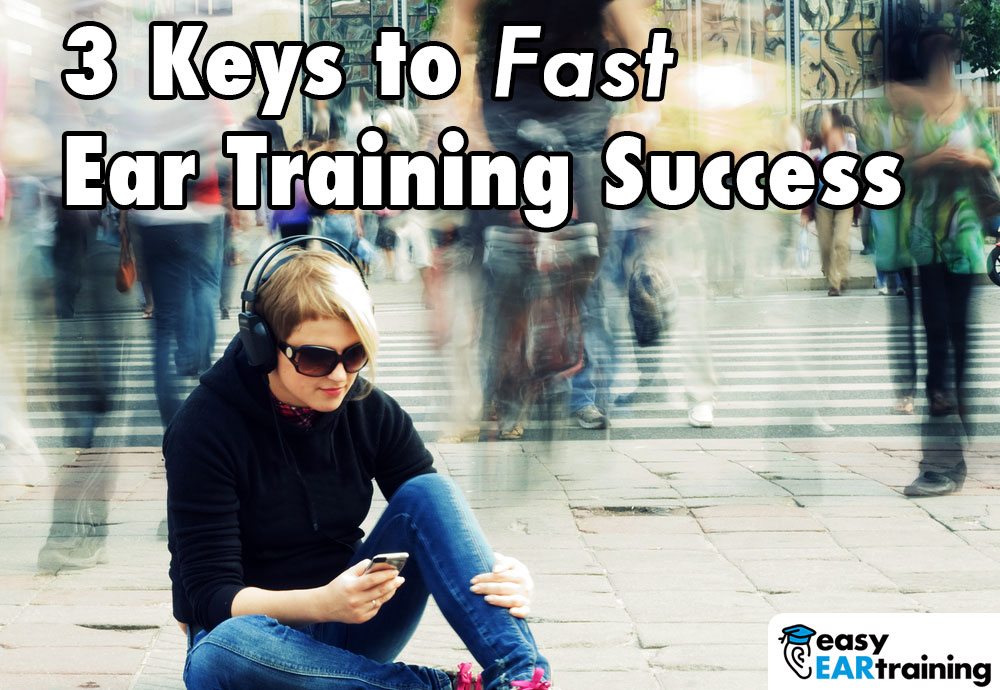When you first start exploring the world of musical ear training, it’s easy to get lost in all the different approaches and conflicting advice out there. From the classical “aural skills” tests (e.g. ABRSM instrument grades), to gospel music “play by ear” tutorials (e.g. Jermaine Griggs of Hear And Play), to interactive games (e.g. Theta Music), the options are endless. And of course we also have our own recommended tools and resources here at Easy Ear Training and Musical U.
There is no one perfect ear training solution – no “one size fits all” – but fortunately, with all the options available today, you have the opportunity to find the perfect ear training approach to suit you – which is why we’re never shy about recommending other sites, products and experts here on EasyEarTraining.com.
 I recently had the pleasure of meeting Scott Edwards of EarTrainingHQ.com, one of the leading ear training providers online. I was delighted to find that we share an inclusive and encouraging attitude towards music education and ear training, and enjoyed discussing how our approaches are similar – and how they’re different. So I invited Scott to join us here on EasyEarTraining.com to talk a bit about how Ear Training HQ works, and his top tips for making fast progress with ear training.
I recently had the pleasure of meeting Scott Edwards of EarTrainingHQ.com, one of the leading ear training providers online. I was delighted to find that we share an inclusive and encouraging attitude towards music education and ear training, and enjoyed discussing how our approaches are similar – and how they’re different. So I invited Scott to join us here on EasyEarTraining.com to talk a bit about how Ear Training HQ works, and his top tips for making fast progress with ear training.
Note: Ear Training HQ just released a fantastic “All Access Pass” option for getting access to all their courses. Look out for a full Ear Training HQ review coming soon, but for now suffice to say: we recommend checking it out!

First of all could you please tell us a bit about yourself and your musical background?
 Well, my name is Scott and I’m from Melbourne, Australia.
Well, my name is Scott and I’m from Melbourne, Australia.
Up until about 17 I was a reluctant musician to say the least. I played the piano as a youngster and switched to the saxophone when I was about 12. I often went to my music lessons begrudgingly and played in the high school bands because some of my friends also did but I was never very enthusiastic.
At 17 I started jamming with some friends on funk and soul tunes and that’s when everything changed. I started practicing constantly and trying to learn how to improvise and play jazz.
I threw away my plans of studying engineering and auditioned to study jazz at university instead.
While I was there I started playing and gigging a tonne but I also developed an almost unhealthy obsession with ear training. As I tamed my wild ears I started focusing more and more on helping others do the same which is how Ear Training HQ came to be.
Over the last few years ear training has practically taken over. I’m playing a little bit, mostly for my own enjoyment and focusing my energy on diving deep into every aspect of ear training and refining my method.
I practiced ear training every day [… ] I started to recognise the occasional note here and there, then complete phrases and eventually I reached my goal of being able to improvise confidently by ear!
Up until I was at university I learned everything from sheet music and I couldn’t hear or recognise a thing. When I made it through the auditions into university I was using my knowledge of scales to make up solos that sounded decent but there was absolutely no connection between my ears and my fingers.
We had ear training classes that I did terribly in, but they didn’t seem to be helping me too much so I started to dive into it on my own. I basically became obsessed. All I cared about was learning to play by ear. By my final year at university I was completely neglecting my saxophone practice in favour of ear training exercises.
This phase lasted about two years. I practiced ear training every day and I cycled through every approach I could find, taking bits and pieces from each one. To cut a long story short, I started to recognise the occasional note here and there, then complete phrases and eventually I reached my goal of being able to improvise confidently by ear!
Ear Training HQ is all about breaking the ear training process down into steps.
I experienced a lot of frustration at times while I was training my ears. And when I looked back on my journey I realised that that frustration came up when I was working on the wrong things. Or sometimes on the right things at the wrong time.
So I’ve focused on breaking the entire process of training your ears down into two linear paths – one focused on hearing music clearly and the other focused on developing relative pitch so you can recognise what you hear.
I’ve found that when you follow the correct sequence with ear training you start seeing results remarkably quickly and it takes the frustration out of ear training.
I’m happy to say that a common thread with our students is speed. That sequence that I just told you about works!
A lot of musicians who have tried a number of different ear training approaches over the years often start with our material and make a huge leap of progress in the first few weeks.
This is an unbelievably rewarding thing to see.
A really surprising discovery has been realising that there’s more to the ear training sequence than I first thought.
I first started with just teaching relative pitch. But I would have some students come back to me who found even the first exercise too challenging. These students were the ones getting really down in the dumps about their ears.
This is when I really started to see that hearing was causing some musicians to struggle with ear training. It didn’t matter what relative pitch exercises they used because they weren’t hearing music clearly and that was holding them back.
Fortunately, hearing is a skill that can be developed just like relative pitch so I started creating exercises that focus on that and built a course for it.
If I’m limited to just 3 they would be:
1. Sing. A lot.
As I mentioned, one of the big surprises for me was discovering that the bottleneck is often a musician’s hearing. As you and I have discussed, singing is without a doubt the best tool for developing your ability to clearly hear each note in music so I recommend that musicians sing as much as possible. Ideally I recommend trying to sing everything you practice – repertoire, scales, transcriptions and everything else. If you can sing everything you play your ears will keep up with your fingers and that’s an amazing place to be.
2. Use a tonality based approach
Next comes relative pitch.
For this I beg everyone to start with a tonality based approach. Whether you choose solfege or scale degrees is up to you, but I firmly believe it’s essential to start with the tonic.
As I mentioned, my philosophy on ear training is all about sequence. There are a lot of approaches that focus on interval training and Easy Ear Training has some great apps that do this but I really believe that interval training actually goes in the advanced ear training category – after you’ve mastered the tonal stuff!
3. Work things out
My last tip is to make sure you’re always trying to work out what’s going on in music when you listen to it.
A lot of musicians think of ear training as a bunch of exercises that are done separately from real music. You and I both make a lot of these exercises and they’re absolutely essential, but as you start developing your sense of relative pitch it’s important to also practice with real music. It really helps you to connect the dots.
To do this I recommend taking a passage that you like and trying to work out the scale degree/solfege syllable of each note. If your sense of relative pitch is developing you may be able to do it by singing the passage slowly a few times. I used to sing passages from film scores to myself to work them out while I was watching movies with my girlfriend. She hated it but it really helped my ears!
If your sense of relative pitch isn’t quite there yet you can use an instrument to work out the notes and then analyse the passage. Just make sure you then sing it back to practice it.
Just one last question: What’s coming up next for Ear Training HQ?
Over the coming months I’m focusing on sight singing.
Up until now I’ve focused on audio exercises. I think audio exercises are essential to succeeding with ear training but they’re perfectly supported by sight singing exercises. And when you combine the two you can make even faster progress.
So I’ve just started working on a series of sight singing exercises that use the approach to sight singing that I’ve used for a long time. It uses scale degrees directly so you don’t need to be able to read notation and like all my ear training it follows a linear path so it’s easy to follow the steps.
We released our All Access Pass earlier this year, which (as the name suggests) gives musicians access to all of our training materials. So I’ll be releasing a collection of these sight singing exercises to our All Access Pass Holders each month. They’re shaping up nicely so I’m excited to get them out there!
Sounds great! Thanks so much for joining us, Scott, and for the excellent advice for ear training students everywhere.
To learn more about Ear Training HQ, their “80-20 Ear Training” course and the new All Access Pass, visit EarTrainingHQ.com!







